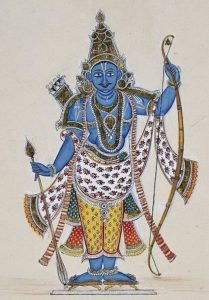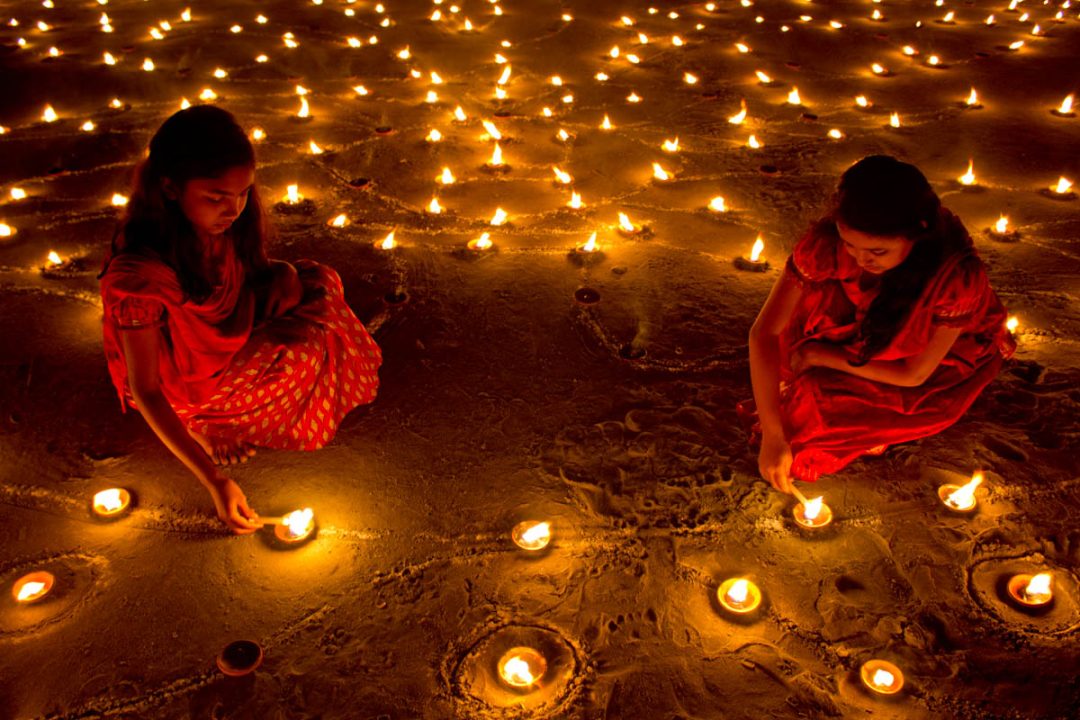Diwali is a short version of Deepavali. Deepam means light in Sanskrit language. Deepavali or Diwali means a row of lights. The legends surrounding Diwali involves various mythological tales from ancient times. Legends also varies between different regions of India.
According to a famous legend of South India, the tale involves Lord Krishna and demon king Bali. Gods were increasingly concerned about the growing popularity of King Bali. They asked God Vishnu for his help. He was the only demon king who didn’t abuse his power. He was also known for his generosity. So Vishnu came as a little boy(Vamana avatar) to Earth and met the king. He asked for three feet of Earth. King Bali agreed to give him against the advice of his mentor. The boy suddenly grew. Since the boy was a reincarnation of Vishnu he measured earth as one foot, sky as the second feet. He asked, “where is my third feet that you promised?” King Bali understood that he was Vishnu’s avatar and bowed by kneeling, and offered his head humbly. Vishnu placed one leg on his head and sent him to an underworld(nether land). He granted him a boon, so that his name will be remembered as a legend for keeping his promise, and his generosity. He also got knowledge as the gift of light. People will celebrate with the lights symbolizing knowledge over ignorance.
According to the South Indian Legend
According to another popular South Indian legend, Narakasura, a demon king abused his power and created havoc and tyranny. He imprisoned women. He stole Lord Surya’s mother’s earring. Gods and saints asked Vishnu to help them. So God Krishna fought with Narakasura. During the battle his chariot’s axis broke due to the loose bolt. His wife Satyabama held the axis together. God Krishna destroyed the demon king. God Krishna’s victory symbolizes the emergence of good over evil, light over darkness. Diwali is a celebration on the basis of this legend also.
According to the North Indian Legend
According to North Indian legend, Lord Rama went to the forest with his wife and a brother Lakshman. Lord Rama went to the forest to fulfill a promise of his dad, king Dasaratha.
 Dasaratha granted his youngest wife a boon that her son Baradha can become the next king. So lord Rama gave up his right as being the rightful heir to the kingdom. During his exile of fourteen years, his wife Sita was kidnapped by Ravana, the demon king. Rama fought with him with the help of many friends like Hanuman. When he returned to the kingdom after destroying Ravana and rescuing his wife Sita, citizens of Lord Rama’s kingdom were thrilled and enjoyed the return of the king with rows and rows of lights.
Dasaratha granted his youngest wife a boon that her son Baradha can become the next king. So lord Rama gave up his right as being the rightful heir to the kingdom. During his exile of fourteen years, his wife Sita was kidnapped by Ravana, the demon king. Rama fought with him with the help of many friends like Hanuman. When he returned to the kingdom after destroying Ravana and rescuing his wife Sita, citizens of Lord Rama’s kingdom were thrilled and enjoyed the return of the king with rows and rows of lights.
Goddess Lakshmi was being incarnated on a new moon day in Hindu month of Karthik(October-November).
Asuras(demons) and Devas(gods and Saints) worked together to obtain the nectar(elixir)of immortality by churning the ocean (Samudra-Manthan). Goddess Lakshmi emerged with the nectar. So Lakshmi booja is being celebrated during Divali days. Goddess Lakshmi is a symbol of wealth, fortune and prosperity. According to another legend, Dhanteras (two days before Diwali is dedicated to Lakshmi, Goddess of wealth, fortune and opportunities and Durga the Goddess of courage, strength(physical and spiritual) . Diwali day is dedicated to Saraswathi, Goddess of wisdom and knowledge which lasts beyond time and space.
Legends surrounding Diwali is a way to explore the mythological tales also. Diwali can be celebrated with families and friends, enjoying, helping to promote peace and prosperity around the world for all people.






